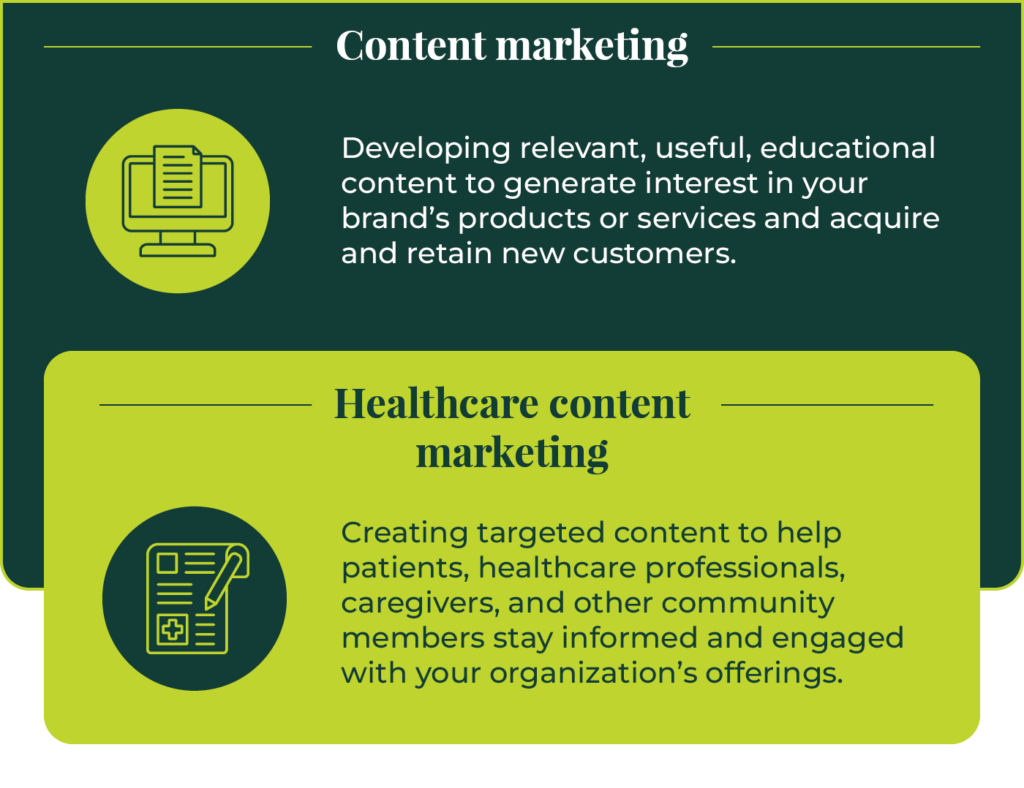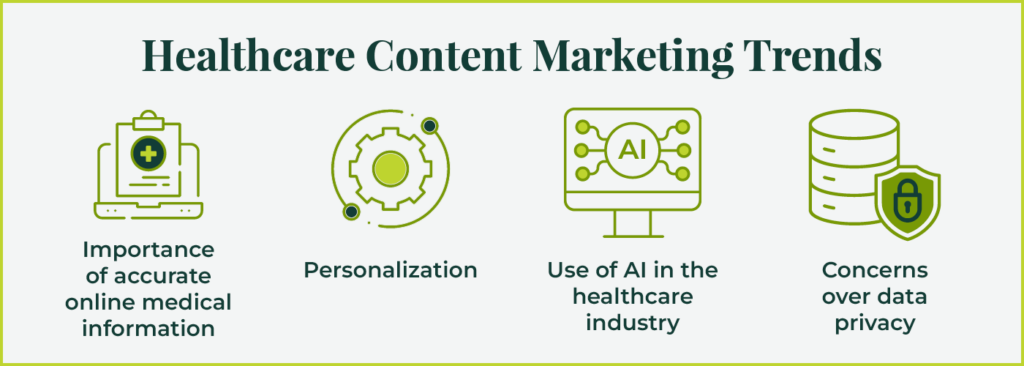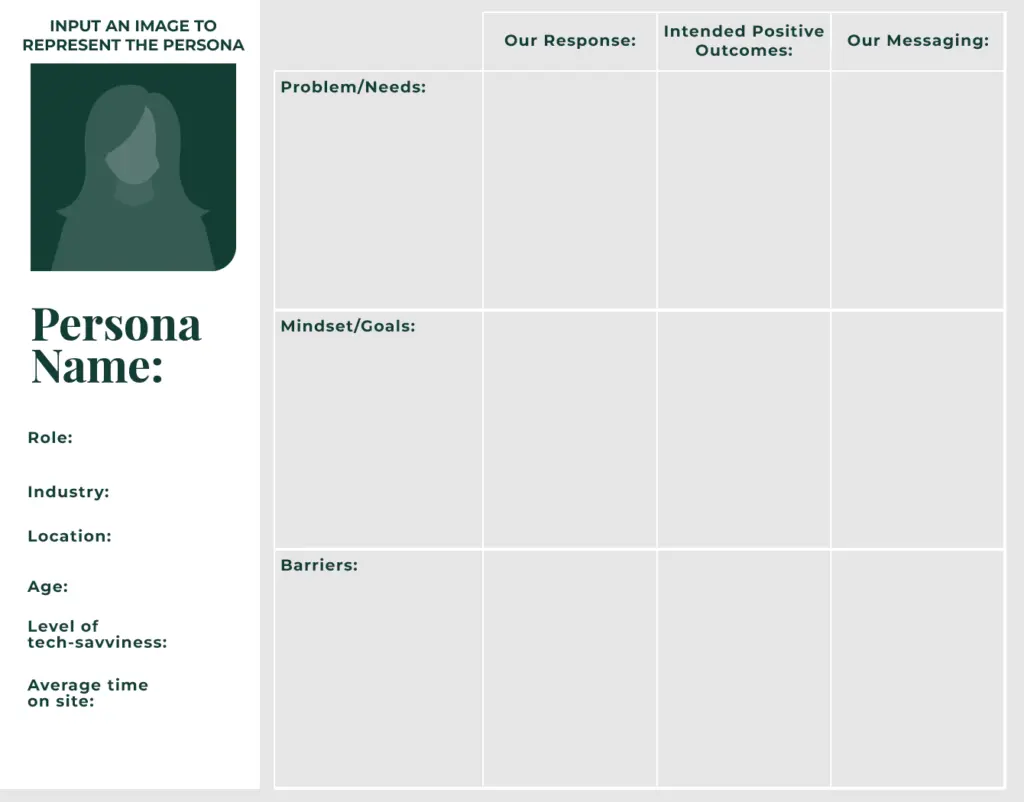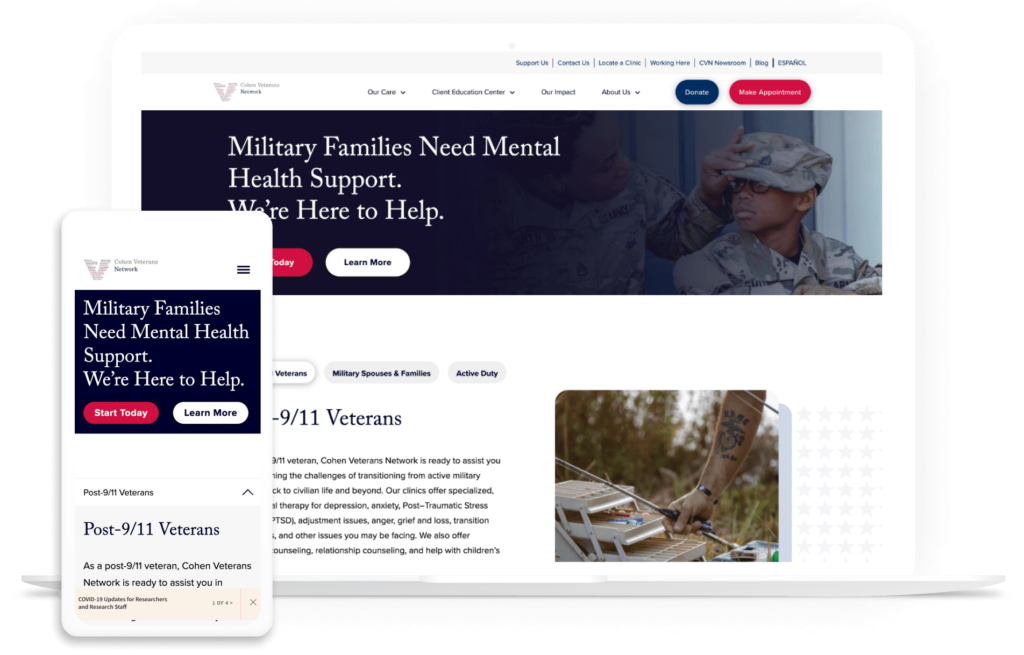Healthcare content marketing is more important than ever before, as increasing numbers of consumers turn to digital channels to resolve their health needs.
60% of American consumers use online scheduling tools to make healthcare appointments. “Dr. Google” is a well-known phenomenon, as almost 90% of patients Google their symptoms before heading to the doctor. Healthcare organizations and their content marketing teams are responding with enhanced digital front doors in light of recent shifts in patient behavior.
However, it can be challenging for healthcare and hospital marketing teams to empower end users while still working to achieve business goals. How can you ensure your site continues to meet patients, physicians, and caregivers’ needs? Focus on making your digital experience as straightforward as possible for visitors to complete tasks, ease patient anxiety, and empower your healthcare workforce.
This guide will cover the ins and outs of healthcare content marketing to help your organization develop a blueprint that works best for your needs. Here’s the roadmap:
- What is healthcare content marketing?
- Why should you develop a healthcare content marketing strategy?
- Healthcare content marketing trends
- Steps to build a powerful healthcare content strategy
- Tools to support your healthcare content marketing
What is healthcare content marketing?
To define healthcare content marketing, let’s first break down how it differs from traditional content marketing:

Content marketing is the process of developing relevant, useful, educational online content to generate interest in a brand’s products or services and acquire and retain new customers.
Content marketing differs from advertising in that it doesn’t rely on explicitly promoting a brand’s offerings. Instead, it serves audience needs by providing valuable informational materials that empower consumers to learn more about a topic and make more informed decisions.
Therefore, healthcare content marketing involves creating targeted content to help patients, healthcare professionals, caregivers, and other community members stay informed and engaged with your organization’s offerings. This content can help build your institution’s credibility, combat online misinformation, and grow your patient base.
Why should you develop a healthcare content marketing strategy?
44% of marketers said improving the quality and value of their content has led to success. Plus, content marketing can drive a high return on investment (ROI) for your healthcare organization. Research shows that content marketing costs 62% less than traditional marketing strategies while generating three times as many leads.

In addition to these concrete benefits, healthcare institutions should develop content marketing strategies because they can use them to:
1. Empower patients with trustworthy information and resources
43% of U.S. consumers say they turn to their doctors for information about new treatment options. With a comprehensive healthcare marketing strategy, you can make this essential health information easier for patients to find and empower them to take charge of their health outcomes.
2. Enhance your organization’s credibility and reputation
Many Americans feel as if the healthcare system has left them behind or isn’t meeting their needs. In fact, less than half of Americans are satisfied with the quality of U.S. healthcare.
A high-quality website with trustworthy content can enhance your healthcare organization’s credibility to help regain any lost trust. Despite the negative trend in public opinion, 76% of consumers still say that they trust their doctor the most for health information. Your content marketing approach can strengthen this trust and help forge stronger bonds with your community.
3. Improve patient acquisition
Many studies and surveys show that a top-notch online presence is necessary for attracting more patients to your healthcare organization. For example:
- 72% of patients read online reviews to help choose a new healthcare provider.
- 43% of patients want to be able to schedule appointments online.
- 77% of people use search engines to launch their patient journeys.
By improving your healthcare organization’s overall online experience, you can attract more new patients and provide a positive first impression of your organization.
Healthcare content marketing trends
Healthcare content marketing and web development trends don’t evolve in a vacuum; they’re highly dependent on the shifting attitudes and behaviors of patients and healthcare professionals. With that in mind, here are four healthcare trends to keep in mind when developing your content marketing strategy:

Importance of accurate online medical information
Over 70% of people say they’ve been exposed to health misinformation at some point, with 82% citing social media as the biggest source of misinformation. Online healthcare misinformation can have real negative consequences, leading people to feel suspicious of vaccines or avoid going to the doctor when they have a medical issue.
Healthcare content marketers should keep this atmosphere of mistrust and misinformation in mind when developing content for their websites. Many consumers don’t know who to trust when it comes to getting accurate information, so your content should reflect reliability and trustworthiness at every turn. Incorporate multiple first-person sources, such as patient or doctor accounts, and studies verified by third-party, reputable sources to enhance credibility.
Personalization
Personalization in marketing is the process of creating content designed to appeal to a specific audience based on their unique attributes and interests. Personalization is becoming increasingly essential, as 71% of consumers expect personalized interactions with brands.
While it may be challenging to create personalized content for every individual in your audience, you can create personalized content for different audience segments, also known as personas. We’ll explore the benefits and uses of personas in a later section.
Use of AI in the healthcare industry
The use of artificial intelligence (AI) in the healthcare industry is growing, with applications for streamlining administrative workflows, patient outreach, clinical documentation, and more. Generally, healthcare AI is considered a supplemental tool and not a full replacement for the work of healthcare professionals.
However, since AI tools are still evolving, they have several limitations and data quality issues healthcare professionals must consider. The error rate for AI tools in the healthcare sector has reached as high as an estimated 23%. In addition, healthcare professionals must be aware of potential biases in AI models. If AI tools are trained using datasets that are not representative of a community’s complete population, they could perpetuate biases or stereotypes in the healthcare space.
These limitations have led to valid concerns among consumers. 60% of Americans say they would feel uncomfortable with healthcare providers relying on AI when administering care.
As a result, healthcare marketers interested in using AI to support their content strategies must tread carefully, weighing the benefits and potential risks of using AI tools. Although healthcare marketers work in a different realm than healthcare providers, marketers’ actions will still reflect on the institution as a whole. Those who do decide to incorporate AI solutions into the content creation process should outline clear policies for:
- Vetting their AI solutions to ensure security and mechanisms to combat bias
- Communicating with audience members about how their AI processes work and how consumers can opt out of having their data used in AI marketing strategies
- Responding to any data or ethical breaches quickly by containing the problem and communicating with affected stakeholders
Concerns over data privacy
Similar to consumer’s fears over the use of AI tools are concerns about health data privacy. One survey found that almost 75% of patients are concerned about protecting the privacy of their health data, and only 20% said they knew the scope of companies and individuals with access to their data.
These concerns emphasize the importance of communicating clearly and transparently with audience members regarding how, when, and why you might use their data in marketing practices. Check out the Cleveland Clinic’s privacy policy for reference. The policy outlines:
- How the organization collects information
- How they use the data
- Who they share the information with
- Security measures they take to keep the data safe
- How consumers can prevent their data from being collected or used
- Procedures for updating the policy
Steps to build a powerful healthcare content strategy
How can you build a content marketing strategy that keeps these key trends and considerations into account while providing value for patients, community members, and healthcare providers? The following best practices will help lay the foundation for a comprehensive content approach.
Tell an inclusive story
A compelling, relatable story from healthcare providers can comfort readers and change minds. It’s also much easier to remember information when told in story form, particularly tales that evoke compassion and empathy.
Inclusive storytelling is about letting the voice of the patient, frontline worker, researcher, or caregiver explain your mission, purpose, and impact. These stories should reflect the diverse communities your organization serves, welcoming and embracing all of your users. Does your organization’s story address people’s problems and fears while leaving them more informed, confident, and at ease?
To help you get started, keep the CDC’s Health Equity Guiding Principles in mind when developing inclusive content. Key guidelines include using:
- A health equity lens. A health equity lens is a multi-pronged communication strategy that involves avoiding the perpetuation of long-standing social and health inequities, reflecting the diversity of your community in your content, and involving the community in the content creation process. It also requires viewing healthcare as intersectional, meaning individuals may experience more than one health or social inequality (as well as strengths and assets) at the same time.
- First-person, humanizing language. For example, instead of saying “the mentally ill” use “people with a mental illness.”
- Inclusive images. Reach out to members of the community to ensure the images you choose reflect their lived experiences. Avoid images that perpetuate negative stereotypes.
From video and text to images and quotes, every piece of content on your website should assist in telling your healthcare organization’s story to site visitors. Inclusive storytelling needs to go beyond an inclusive image or two; your user research, tone and style, and team structures should all reflect your healthcare organization’s emphasis on inclusivity.
Create audience personas
Personas are fictionalized representations of different audience segments. They often include the following characteristics:
- Name, location, and age
- Industry or job title
- Level of tech-savviness
- The problem the person is experiencing
- How your organization can solve their problem
- Barriers to connection
- Messaging your organization should use to connect with the person
It’s generally recommended to develop around three to five personas. For example, your healthcare website might have personas for patients, healthcare providers, patient families, staff, and donors. Use this template to build personas for your organization:

After developing your personas, you can start creating content that appeals to each group. Determine what topics each audience is most interested in. For example, patients may want easy access to doctor profiles or symptom checkers, while donors are interested in how your organization uses gifts to fund its mission.
Before you create a new piece of content, review your personas and ask yourself:
- Who is the intended audience?
- What problem, question, or issue does the audience have?
- How can you help solve their problem through your content?
- How can you reduce barriers to make it easier for your audience to find your content and implement your recommended solutions?
Focus on the user journey
People expect timely, accurate, and actionable solutions to medical problems. Healthcare marketers are responding with educational content that aligns with community needs. By engaging people early in the healthcare journey, marketers can guide them on a path to improved health and gain trust and brand loyalty while achieving content marketing goals in the process.
What pathways do you guide visitors on when they arrive on your website? Do those pathways quickly and easily help visitors do what they came to your site to do?
By exploring the patient journey and developing UX personas, you can better understand how people get to your site and what they expect to do once there. You can also identify any existing barriers that stop them from completing critical tasks on your healthcare website.
Take the International OCD Foundation website, for example. The website’s homepage has a variety of CTAs and links based on different users’ goals and motivations. This includes ways to find help, learn more about OCD, or get involved in supporting those with OCD.

Kanopi helped the foundation conduct user experience research to identify users’ needs and design the site to help them complete their goals faster. Plus, we helped add tailored features like better site navigation to facilitate a smoother user experience.
In addition to these larger user-experience considerations, consider a few quick fixes to simplify the online journey even further. For instance, banners or alert messages can help bring emergency or vital information front and center for patients. Also, from chatbots to call buttons and contact forms, all of your contact methods should be consistently placed and static on every page of your site to help patients contact you in a way that suits them.
Prioritize accessibility
27% of U.S. adults self-identify as disabled. On top of this, people visiting healthcare sites may be experiencing an elevated level of stress that can be a distraction.
To help counter this, keep your user journey clear from distraction as you build an accessible web presence. The Web Content Accessibility Guidelines (WCAG) go deep into recommendations for developers, but here are three quick steps you can take as a content strategist to improve your site’s accessibility:
- Ensure your site has simple, straightforward navigation and that all non-textual content has alternative text that can be interpreted by screen readers. Also, it’s good to keep in mind that Google uses alternative text when ranking images. Ensuring alternative text exists throughout your website will impact your site’s visibility on search engines, in addition to boosting your content marketing goals.
- Use easy-to-read fonts and colors with significant contrast to ensure the content on your site is readable by site visitors with vision and cognitive impairments.
- Ensure all content on your site has a logical content heading structure. That means using a single H1 tag (usually your page title) and keeping other header tags in sequential order. Sequential heading order helps assistive technologies better navigate your site while indicating to Google the general outline of the content. It can even impact your search engine results page (SERP) display.
Test your website for accessibility about three to four times per year. You can use automated accessibility tools, such as Lighthouse or WAVE, to identify accessibility issues. However, automated tools should be just the starting point. Manually test your website for accessibility to replicate the user experience and ensure you don’t miss any problems.
Review Kanopi’s guide to accessibility testing for tips on how to use keyboard navigation and other techniques to manually test your website.
Simplify your language
People read differently online than they do offline, especially when under stress. The truth is we read very little online. Instead of reading every word, we scan web pages for the information we need.
With this in mind, follow these tips to improve your online content’s readability:
- Make your content scannable. Make sure you’re using clear and straightforward language, bullet points, buttons, and bold text to assist visitors as they scan your site.
- Avoid using all capitalization. All caps reduces your content’s readability because all words have a uniform rectangular shape, meaning readers can’t identify words by their shape. Checking your site doesn’t use all capitalization also ensures it’s accessible to the 15-20% of the population who experience dyslexia, as all capitalized letters are harder for them to read.
- Avoid jargon. Medical jargon, although sometimes necessary, can confuse site visitors. Try to keep the use of complicated terminology to a minimum to keep site visitors engaged and give your content marketing efforts a helping hand. When this is unavoidable, offer links to definitions or simply spell out acronyms the first time they are used to ease the user’s journey.
- Determine whether text is the best way to get across essential information. For example, could an infographic with key stats or an interactive data visualization better serve your healthcare site users? Could a short video help get vital information to site visitors more effectively than words? Explore how you can visually validate the work you do and the care you provide to patients.
- Offer translations. Keep in mind that English is a second language for many while writing content on your website. Think about actions you could take to make it easier for users to translate your site into other languages, such as using a translation service or premium extension.
Taking these steps helps simplify the user journey as much as possible, ensuring that visitors can find the information they’re looking for with minimal stress.
Emphasize credibility
As mentioned above, trustworthiness is one of the most critical elements to consider when crafting your healthcare content marketing approach. When audience members know they can have faith in your website to deliver reliable, accurate content, they’ll return to your site again and again and be more likely to take advantage of your services.
Incorporate the following types of content into your marketing strategy to project credibility:
- Interviews or blog posts authored by subject matter experts (SMEs). Coordinate with healthcare professionals at your organization to leverage their expertise in your content. Interview doctors, nurses, and other professionals and include direct quotes in content like blog posts and case studies. Invite healthcare providers to write blog posts for your website to discuss topics they’re passionate about or areas they’re currently researching.
- Statistics or citations from credible sources. Make sure any sources you cite in your content are reliable and credible. This usually includes sources like peer-reviewed journals, government agencies, or accredited health organizations. Directly link to these sources so readers can verify their legitimacy.
- Updated, fresh content. Keep your blogroll and news articles fresh by updating your website at least once a day with new content. This shows audiences that your institution is keeping up with the latest research, news, and reports. Readers will appreciate having access to updated, accurate medical information. Include dates on when the content was last updated so readers know how current the content is.
- Balanced information. Your content should be clear, transparent, and balanced. Provide an unbiased perspective that sticks to the facts and avoids sensationalizing or exaggeration. This can reassure audience members who may feel confused or anxious about a medical issue and help reduce their fears.
Take a look at the Mayo Clinic’s website for an example of an effective way to showcase trustworthy healthcare information. The website features a robust medical directory where visitors can research everything from their symptoms to information about clinical trials, drugs and supplements, and more.

Revive your calls to action
Calls to action (CTAs) are the buttons and links you use to invite website visitors to take a certain action. Your healthcare CTAs should:
- Tell site visitors why they should do something. Don’t just tell visitors what you want them to do; provide the why behind the action. For example, take a look at this pop-up CTA on the Boston Children’s Hospital site. The CTA requests that supporters donate now to get their gift doubled, but first provides the context that donations help more children in need.

- Make it clear what visitors will see when they click on your CTA. Users should know exactly what to expect when they click on your CTAs. For example, let’s say you’re creating a CTA encouraging visitors to become a peer-to-peer fundraiser to support your healthcare organization. Many site visitors may not know what peer-to-peer fundraising entails, so make your CTAs more specific and clear. You could use text like, “Sign up here to help raise funds on behalf of Sunshine Children’s Hospital.”
- Be accessible. Use bold fonts, large buttons, and strong color contrast to help your CTAs stand out and be accessible to all audiences. Use simple language and avoid jargon in your CTAs.
Let’s take a look at the Cohen Veteran’s Network website CTAs. The website has many helpful buttons for users with a variety of goals and needs. These buttons include:

- Find a Clinic
- Watch Video
- Call a Clinic
- Our Impact
Each button stands out against the background with bold letters and high-contrast colors.
Cohen Veteran’s Network partnered with Kanopi to help update their web presence after they expanded from 2-3 clinics to 12-15 clinics in six years. We helped modernize their site, update their user personas, enhance branding, improve navigation, and more. Read the full case study for more information.
Refine your SEO strategy
When developing a healthcare content strategy, search engine optimization (SEO) may sometimes feel like an afterthought or an added level of complexity to your processes. However, don’t neglect the benefits that SEO can bring to your marketing approach. SEO can help get your content in front of new audiences, enhance your credibility, and even bring new patients into your practice.
One of the easiest and most effective ways to improve your SEO strategy is to prioritize the user experience. Of course, don’t neglect elements like including a compelling meta description or a clickable page title. But to design content that ranks well, it should be created with the user in mind, not a search engine algorithm.
Here’s what Google says about creating people-first content:
“Google’s automated ranking systems are designed to present helpful, reliable information that’s primarily created to benefit people, not to gain search engine rankings, in the top Search results.”
To create content that works for your audience and helps achieve better SEO results, Google recommends putting yourself in your audience’s shoes and keeping these tips in mind:
- Write content that you would share with a friend or recommend on social media.
- Develop original material that goes beyond the obvious to spotlight new angles or valuable insights.
- Provide transparent sourcing that makes it clear the content was written by or constructed with the help of an expert.
- Create action-focused content that helps a user achieve a specific goal.
- Don’t rely on generic outputs produced by generative AI solutions—ensure your content has a clear perspective and distinctive point of view.
- Avoid simply summarizing other existing content and ensure any new content provides real value to a reader.
Don’t neglect the technical aspects of SEO, either. Often, you can improve your website’s rankings with a few backend fixes that help promote better page performance. Leverage an SEO checklist or a free tool like PageSpeed Insights to identify areas for improvement.
Use multichannel marketing
Cross-channel or multichannel marketing offers plenty of benefits over single-channel marketing. Businesses that use at least four different channels can see ROI increases of up to 300%. In addition, it can take up to eight touchpoints with a consumer to make a sale. Leveraging multiple marketing channels allows you to carry out a variety of unique touchpoints without coming off as overbearing.
Promote your web content and message across platforms like:
- Social media
- Other blogs (via guest blogging)
- Direct mail
- Press releases
Ensure all of your marketing materials are uniformly branded to promote cohesion and brand recognition. Use the same fonts, colors, logos, and tone across all channels to reinforce your nonprofit’s message.
Tools to support your healthcare content marketing
Plenty of software solutions and tools can help streamline your nonprofit’s workflow as you implement the tips in this guide. Search for solutions that integrate with your existing software platforms to enable seamless data migrations.
Here is a quick overview of some tools you might find useful in the content creation process:
- Generative AI. Generative AI solutions like ChatGPT and Bard can help generate content ideas, develop blog post outlines, and adjust your writing for specific audiences. Just be sure to review any outputs you receive from these tools for accuracy. Avoid using AI content verbatim because it can often be generic or even plagiarized, which can have negative SEO consequences.
- Design tools. Graphic design tools can help you keep up with content design trends and craft visually appealing marketing collateral. Free tools like Canva and Adobe Express are a great place to start.
- Healthcare content management system (CMS). WordPress and Drupal tend to be the best options for organizations with complex needs, like healthcare organizations. That’s because these platforms are highly scalable and offer advanced security features. Plus, they are very user-friendly, allowing users without extensive web development experience to add and refresh content.
- Marketing platforms. Marketing platforms can be invaluable for cross-channel promotions. Consider email-focused tools like MailChimp and Constant Contact, social media scheduling platforms like Hootsuite, or multi-platform solutions like HubSpot.
- Analytics. Website analytics solutions help measure the effectiveness of your content marketing approach by tracking metrics like online conversions, bounce rate, time on page, and more. In addition, user behavior tools like HotJar can be valuable for understanding the user experience through heatmaps and user surveys. However, be sure to carefully vet your analytics solutions and tracking tools to ensure they don’t lead to any HIPAA violations. Use our roundup of HIPAA-compliant analytics tools to find the right solution for your healthcare website.
It can be beneficial to work with a web design and development professional to help understand which tools will work best for your organization and how to get the highest ROI out of your software solutions.
Kanopi can help build a powerful healthcare content marketing strategy
Kanopi has partnered with many healthcare organizations over the years, enabling us to develop tried and tested best practices for healthcare content strategy.
We have a solid understanding of the unique challenges you face when delivering your healthcare content strategy. We work collaboratively to find improvements and enhancements to your online presence that bolster your content marketing efforts and meet business needs, all while helping your users complete the tasks they came to your site to complete quickly and easily.
Through inclusive storytelling, focusing on the patient journey, and ensuring your site is accessible, you can create a site that meets your users’ needs and your content marketing goals.
Contact us today to ensure your site meets your users’ needs and your content marketing needs through a robust content strategy, an intuitive user interface, accessible and inclusive content, and a comfortable mobile experience.
Additional healthcare content marketing resources
Looking for more resources to build your content marketing strategy? Start here:
- Webinar: Website Best Practices for an Aging Population. Kanopi’s Cliff Persaud discusses the challenges and opportunities facing healthcare providers, and how they can ensure their website design meets the needs of aging patients.
- 9 Best Healthcare Website Design Examples (and Expert Tips). Your healthcare website’s design plays an important role in your audience’s opinions of your organization. Review these examples for inspiration.
- 7 Best Hospital Web Development Examples. Hospital websites have specific considerations to keep in mind to build a website that effectively meets audience needs. This guide has everything you need to know about hospital web development.
- Healthcare Website Design | Kanopi Studios. Ready to launch your healthcare content marketing strategy with expert support? Reach out to Kanopi here for a healthcare website consultation.









